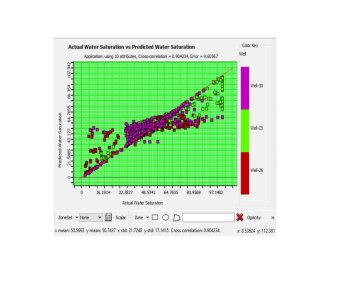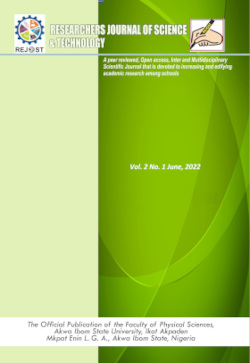Utilizing Probabilistic Neural Network for Reservoir Assessment: A Case Study from an Onshore Niger Delta Field
Keywords:
PNN, reservoir characterisation, deterministic inversion, water saturationAbstract
Accurate reservoir characterization is often useful in defining the boundaries of prospective oil or gas fields as well as in lessening the likelihood of drilling ineffective wells. Identifying fluid and lithology in heterogeneous and complex reservoirs, such as those found in the Niger Delta, is a difficult task. However, conventional seismic attributes cannot easily characterize such heterogeneous and complex reservoirs. It is critical to understand the complexities of reservoir characteristics and associated uncertainties using integrated multisource data and more robust approaches. Consequently, this piece of work is aimed at characterising the reservoir 3D water saturation volume by employing the probabilistic neural network (PNN) analysis of full-stack seismic data and water saturation logs. In this case study, two reservoirs from the onshore Niger Delta's Sigma field were set aside for characterization. A high-resolution saturation volume was predicted using well log measurement and the results produced tremendous outcomes. The predicted water saturation volume and the actual saturation logs had a 0.90 normalized correlation. The outcomes validate the ability of the workflow to precisely forecast water saturation at a greater resolution.
References
Adojoh O., Marret, F., Duller, R. and Osterloff, P. (2017). Tropical palaeovegetation dynamics, environmental and climate change impact from the low latitude coastal offshore margin, Niger Delta, Gulf of Guinea. Palaeoecology of Africa, Vol. 34, pp. 107 - 144.
Akpan, A. S., Obiora, D. N., Okeke, F. N., Ibuot, J. C., & George, N. J. (2020a). Influence of wavelet phase rotation on post stack model based seismic inversion: A case study of X-field Niger Delta, Nigeria. Journal of Petroleum and Gas Engineering, UK, 11(1), 57–67. https:// doi.org/ 10.5897/ JPGE2 019. 0320
Akpan, A. S., Okeke, F. N., Obiora, D. N., & George, N. J. (2020b). Modelling and mapping hydrocarbon saturated sand reservoir using Poisson’s impedance (PI) inversion: A case study of Bonna field Niger Delta Swamp Depobelt, Nigeria. Journal of Petroleum Exploration and Production Technology Germany, 11, 117–132. https:// doi. org/ 10. 1007/ s13202- 020- 01027-8
Akpan, MJ. George, NJ. Ekanem, AM, Ekong, UN (2022) Ekong Petrophysical appraisal and 3D structural interpretation of reservoirs in an Onshore Niger Delta Field, Southeastern Nigeria, International Journal of Energy and Water Resources. https://doi.org/10.1007/s42108-022-00218-9
Daily, G.C. (1976). A possible mechanism relating progradation, growth faulting, clay diapirism and overthrusting in a regressive sequence of sediments. Bull. Can. Petrol. Geol. 24, 92–116
Dim, C.I.P. and Onuoha, K.M. (2017) Insight into sequence stratigraphic and structural framework of the onshore Niger Delta Basin: integrating well logs, biostratigraphy, and 3D seismic data. Arab. J. Geosci. 10(14), 1–20
Doust, H. and Omatsola, E.: (1990) Niger Delta: In: Edwards, J. D., Santogrossi, P.A., (Eds.), Divergent/passive margin basins. American Association of Petroleum Geologists Bulletin Memoir 48, 239–248
Edwards, M.B. (2000) Origin and significance of retrograde failed shelf margins. Tertiary northern Gulf Coast Basin. Trans. Gulf Coast Assoc. 50, 81–93
Ejedawe, J. E. (1981). Patterns of Incidence of Oil Reserves in Niger Delta Basin. American Association of Petroleum Geologists, 65, 1574-1585.
Ejedawe, J.; Love, F.; Steele, D.; Ladipo, K. (2007). Onshore to deep-water geologic integration, Niger Delta. An in-house presentation pack of the Shell Exploration and Production Limited, Port-Harcourt
Ekanem, A. M., George, N. J., Thomas, J. E., & Ekpenyong, NE. (2021). Seismic modelling study of CO2 effects on P-wave amplitude. Modeling Earth Systems and Environment, China. https:// doi. org/ 10. 1007/ s40808- 020- 00904-9
Ekanem, A. M., Ikpe, E. O., George, N. J. & Thomas, J. E. (2022a). Integrating geoelectrical and geological techniques in GIS-based DRASTIC model of groundwater vulnerability potential in the raffia city of Ikot Ekpene and its environs, southern Nigeria. International Journal of Energy and Water Resources. https:// doi. org/ 10. 1007/ s42108- 022- 00202-3
Ekanem, K. R., George, N. J., & Ekanem, A. M. (2022b). Parametric characteriza-tion, protectivity and potentiality of shallow hydrogeological units of a medium-sized housing estate, Shelter Afrique, Akwa Ibom State, Southern Nigeria. Acta Geophysics. https:// doi. org/ 10. 1007/ s11600- 022- 00737-3
Ekweozor, C.M.; Daukoru, E.M. (1984). Petroleum source-bed evaluation of Tertiary NigerDelta; discussion and reply.Am. Assoc. Pet. Geol. Bull. 68, 387–394
Evamy, B.D.; Haremboure, J. Kamerling, P. Knaap,W.A. Molloy, F.A.; Rowlands, P.H. (1978). Hydrocarbon habitat of Tertiary Niger Delta. Am. Assoc. Pet. Geol. Bull. 62, 1–39
Hampson, D. P., J. Schuelke, and J. Quirein, (2001), Use of multi-attribute transforms to predict log properties from seismic data: Geophysics, 66, 220–236, doi: 10.1190/1.1444899.
Horsfall, O. I., Uko, E. D., Tamunoberetonari, I. & Omubo-Pepple, V. B. (2017). Rock Physics and Seismic-Inversion Based Reservoir Characterization of Akos-Field, Coastal Swamp Depobelt, Niger Delta, Nigeria. IOSR Journal of Applied Geology and Geophysics (IOSR-JAGG) 5, (4),59 – 67
Inichinbia, S; Sule, P; Ahmed, AI; Hamza, H; Lawal, KM (2014). Petrophysical Analysis of Among hydrocarbon field Fluid and Lithofacies using well log data. IOSR J. of Appl. Geol. and Geophy. 2 (2): Ver I. 86 – 96.
Mohamed, I, S., Hemdan, M., Hosny, A, and Rashidy, M. (2019). High-resolution water-saturation prediction using geostatistical inversion and neural network methods. Interpretation, 7 (2). p. T455–T465
Knox, G.J. and Omatsola, E.M. (1987). Development of the Cenozoic Niger Delta in terms of the “Escalator Regression” model and impact on hydrocarbon distribution. In: Proceedings KNGMG Symposiumm “Coastal Lowlands, Geology and Geotechnology,” pp. 181 – 202. mKluwer, Dordrecht
Kulke, H. (1995). Nigeria. In: Kulke, H., Ed., Regional Petroleum Geology of the World, Part II, Africa, America, Australia and Antarctica, Gebruder Borntraeger, Berlin, 143-172.
Mohamed, I. A., H. El-Mowafy, and M. Fathy, (2015). Prediction of elastic properties using seismic prestack inversion and neural network analysis: Interpretation, 3, no. 2, T57–T68, doi: 10.1190/INT-2014-0139.1.
Mohamed, I. A., H. El-Mowafy, D. Kamel, and M. Heikal, (2014). Prestack seismic inversion versus neural-network analysis: A case study in the Scarab field offshore Nile Delta, Egypt: The Leading Edge, 33, 498–506, doi: 10.1190/tle33050498.1.
Mohebali, B; Tahmassebi, A; Meyer-Baese, A; Gandomi, A H. (2020). Probabilistic neural networks: a brief overview of theory, implementation, and application. Elsevier. pp. 347–367.
Okeugo, C. G., Onuoha, K. M., Ekwe, C. A., Anyiam, O. A. and Dim, C.I.P. (2018). Application of Crossplot and Prestack Seismic-Based Impedance Inversion for Discrimination of Lithofacies and Fluid Prediction an an Old Producing Field, Eastern Niger Delta Basin. Journal of Petroleum Exploration and Production Technology. 9 (1). 97–110.
Onuoha, KM. (1999). Structural features of Nigeria’s coastal margin: An assessment based on age data from wells. Journal of African Earth Sciences, 29, 485 – 499.
Sebtosheikh, M.A., Motafakkerfard, R., Riahi, M.A., Moradi, S., Sabety, N., 2015. Support Vector Machine Method, a New Technique for Lithology Prediction in an Iranian Heterogeneous Carbonate Reservoir using Petrophysical Well Logs. Carbonates Evaporites. 30 (1), 59 – 68.
Short, K.C. and Stauble, A.J. (1967). Outline of geology of Niger Delta. Am. Assoc. Pet. Geol. Bull. 51, 761–779
Stacher, P. (1995). Present Understanding of the Niger Delta Hydrocarbon Habitat. In (Eds.) Oti, O. & Postman, G., Geology of Deltas.Rotterdam, Netherlands: Balkema Publishers. pp. 257-267.
Stacher, P. (1994). Niger delta hydrocarbon habitat. Niger. Assoc. Pet. Explor. Bull. 9(10), 67 – 75.
Todorov, T. I., (2000). Integration of 3C-3D seismic data and well logs for rock property estimation: M.S. thesis, University of Calgary.
Weber, K.J. and Daukoru, E.M. (1975). Petroleum geology of the Niger Delta. In: Proceedings of the 9thWorld Petroleum Congress, Geology, vol. 2, pp. 210 – 221. Applied Science Publishers, Ltd., London.
Xiao, H. and Suppe, J. (1992). Origin of rollover. Am. Assoc. Pet. Geol. Bull. 76, 509 – 229.
Lehner, P., and P. A. C. De Ruiter, (1977). Structural history of Atlantic margin of Africa: AAPG Bulletin, v. 61, p. 961 –981.

Downloads
Published
How to Cite
Issue
Section
License

This work is licensed under a Creative Commons Attribution-NonCommercial-NoDerivatives 4.0 International License.




